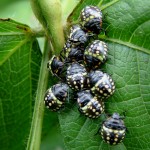Podsucking bugs* (green vegetable bug, redbanded shield bug, brown bean bugs, brown shield bug) in summer pulses (soybean, mungbean, navy bean, adzuki bean)
- View a diagram of Green vegetable bug life cycle
- View images of podsucking bug nymph stages at the Beatsheet Blog
| Pre-plant/Seedling/Vegetative | Budding/ Flowering | Podset | Podfill | Podripening/Harvest | |
|---|---|---|---|---|---|
| Insects and damage | Sequential plantings of summer legumes allow podsucking bugs to move progressively from early to later plantings – building to very high levels in later plantings. | No damage unless very high populations (>10 adults per m2). | No damage unless populations are high. Look for egg rafts and clusters of nymphs as any damage will not be visible. | Critical stage for bug damage: deformed & shrivelled seed and reduced yield. | Crops still at risk of deformed and shrivelled seed until pods are dry.
Blemished seed is difficult to grade out and results in downgrades in quality. Damaged seed is also prone to weathering. |
| Monitoring | Check for overwintering adults in preceding season’s crop and weed hosts | Monitor using a beat sheet twice weekly early to mid-morning. Take 5 samples within 20 m radius; repeat at 6 random sites as nymphs tend to be clumped.
Look for egg rafts on plants, and beneficial insects. Bugs can be found basking in the sun in the top of the canopy early in the day. |
Pods most at risk are those containing well developed seed | ||
| Beneficials | A number of beneficals attack pod sucking bugs but rarely regulate populations.
|
||||
| Cultural control |
|
Set harvester up to screen out damaged seeds | |||
| Thresholds | High numbers of young nymphs inflict very little if any damage until podfill.
Thresholds are based on seed quality, are typically low (<1 bug/m2), and are expressed in green vegetable bug equivalents (GVBEQ). Other podsucking species are converted to GVBEQ and totalled.
Podsucking bug threshold at podfill (GVB/m2) = number of seeds per square metre*0.25/1000. The more seeds a crop sets, the higher the bug threshold as damage penalties are based on % seed damage. Pod-sucking bug thresholds can be determined with economic threshold calculators |
||||
| Pesticides | Delay spraying until podfill, as no selective options are available, and unless there are very high numbers, spraying before podfill has no economic benefit. At flowering and early pod-set, many immature bugs are in the egg stage (not controlled by insecticide), so delay control to conserve beneficials that attack podsuckers, helicoverpa, mites and whitefly.
The addition of 0.5% salt (Na/Cl) to tank mixes of deltamethrin will control 60% of red banded shield bugs which are not controlled with the chemical alone. Control at early to mid-podfill. Start at early podfill if populations are >4 adults/m2. Soft options for sucking pests are limited. |
If high sustained bug pressure, a late spray may be necessary. Observe pesticide withholding periods | |||
| Multi-pest considerations | To reduce the risk of flaring silverleaf whitefly, mites and helicoverpa, delay spraying for podsucking bugs until early podfill. The addition of 0.5% salt reduces the need for full rates of insecticides and is less damaging on beneficials | ||||
| Communication | Discuss spray management plans with neighbours and consultants (see area wide management)
Industry publications provide up to date information about regional pest issues. |
||||
*Podsucking bug species: Green vegetable bug (GVB) Nezara viridula, redbanded shield bug Piezodorus oceanicus, brown bean bugs Melanacanthus and Riptortus sp., brown shield bug Dictyotus caenosus.
Further information
- Podsucking bugs (DAF Queensland)
- Insect pest management in soybeans (DAF Queensland)
- Certified Mungbean agronomy course – Australian Mungbean Association

